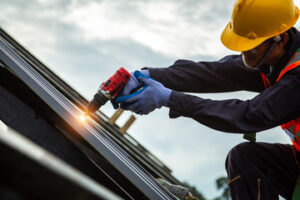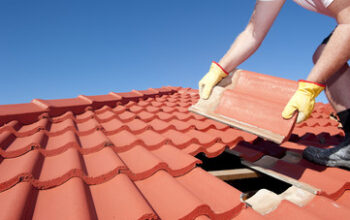The right repair methods and materials protect your investment. Make sure to use a sealant designed for your specific roofing material and follow manufacturer guidelines carefully.
Regular inspections help you spot minor problems early, before they grow into major headaches. Addressing them promptly minimizes damage and averts structural issues. Visit https://wwwcedarparkroofingpro.com to learn more.
Roof repair is generally more cost-effective than replacement for localized damage. However, if your roof is older or sustained widespread damage, replacement may be the better long-term solution.
If your roof is missing shingles or has holes in its surface, it should be repaired immediately. A gaping hole in the roof can allow water to infiltrate your home and cause damage to ceilings, walls, insulation, and other areas. Additionally, pests can enter your home through these gaps and cause further issues.
The easiest way to check for damaged shingles is by visually inspecting your roof. Look for cracks, dents, and discoloration of the roof tiles. Also pay attention to areas that are prone to collecting debris, such as valleys or the edges of chimneys. If you spot any discoloration or water stains on the ceilings or walls, it could indicate a leaky roof caused by a faulty tile.
Another sign of a problem is if the shingles are curling up or appearing to buckle. Curling shingles can be caused by temperature changes or aging of the roof. Regardless of the cause, this is a sign that the roof is reaching the end of its life and needs to be replaced.
When repairing a damaged shingle, it is important to remove the shingle above and below it. If you only replace one shingle, it will likely fall off in the next storm. Use a flat pry bar to lift up the damaged shingle and expose the nails below it. Then, slide the pry bar under the shingle above and pull out the nails. Then slide the replacement 3-tab shingle into place and nail it down with four roofing nails.
If you are unable to locate the source of the damage, you may need to perform a more detailed inspection to determine what is causing your roof to leak. You will need to inspect the area around each suspected leak location carefully for a broken protective membrane. Once you have found a compromised membrane, it will be necessary to repair it using roofing cement. After you have repaired the damaged membrane, it is important to ensure that the new tile fits snugly and aligns correctly with the rest of your roof. This will help prevent future leaks and ensure that your home is properly insulated.
Leaks
The presence of leaks in your home indicates that you have a serious roofing problem, one that needs immediate attention to prevent further damage and protect the health and safety of everyone who lives there. Leaks may be obvious, with water pouring down the ceiling or stains that appear on the walls and floor. Alternatively, they can be more subtle, with damp areas or a sagging roof that creates gaps for light to shine through.
When a leak occurs, you may need to run around with pots and buckets in order to catch the water that drips from the ceiling. The good news is that a professional roof repair service can often fix these problems before they cause extensive damage.
Many leaks develop in valleys where two roof planes meet or around roof features like vents, chimneys and skylights. The flashing material that seals these areas can deteriorate over time, especially if it is exposed to sun and wind. This is why it is important to inspect and maintain these areas regularly.
Another common cause of leaks is the improper installation or servicing of rooftop equipment such as air conditioning ducts and fans. These can suck rainwater into the building, leading to mold and mildew. Regular inspections can prevent this type of damage, and it is also a good idea to have roof maintenance professionals clean and service your rooftop equipment when needed.
Roof leaks should never be ignored, as they can lead to mold and mildew growth, rot in beams and walls and a decrease in property value. Fortunately, the majority of these issues can be prevented with regular maintenance and timely inspections.
The cost of repairing or replacing your roof will depend on the severity of the damage, its location and how accessible it is to repair professionals. It is also influenced by the cost of materials and labor, which vary according to their quality. It is recommended that you contact a professional roofer for a roof inspection and repair quote. This will allow you to get the most accurate estimate possible for your roof repair.
Sagging
Even the best-built roofs don’t last forever, and a sagging roof is more than just an eyesore. A sagging roof can weaken the overall structure of your home, leading to cracks in walls and ceilings, water damage, and mold growth. Addressing a sagging roof promptly can protect your home from further damage and save you money in costly repairs down the road.
A sagging roof can be due to many factors, but it typically points to deeper problems with rafters or support systems. For example, if there’s a noticeable dip or sagging in the middle of your roof, it could indicate that your rafters are not supporting the weight of your roof properly. A professional can evaluate your roof and identify any issues that need to be fixed.
The most common cause of a sagging roof is a broken truss or rafter. To fix this issue, you’ll need to install a steel “L” shape channel to reinforce and repair your broken trusses or rafters. This will help to distribute the weight evenly across your roof and prevent future sagging. You may also want to consider adding support beams between rafters or using joist jacks to temporarily lift the sagging area and prevent further damage until permanent repairs can be made.
Your roof protects your home from the elements, and it’s essential to ensure it can withstand the constant stress of rain, hail, snow, and wind. However, your roof is only as strong as the materials and craftsmanship used to build it. Poorly constructed roof joints and rafters, inadequate storm bracing, and water damage can all lead to a sagging roof.
Sagging is normal for most homes, but if your roof starts to sag, it’s important to get it repaired right away. Ignoring the problem can lead to structural damage and expensive repairs in the future.
Working in the attic to repair a sagging roof can be dangerous, so you should always hire a professional. A professional roofing contractor will have the expertise and tools necessary to quickly and safely repair your sagging roof.
Flashing
Designed to keep water out of the building, roof flashing is installed around areas where leaks are more likely to occur. These include areas where different sections of the roof meet or intersect with other structures such as chimneys, vent pipes, and skylights. Typically made of metal, these waterproof strips are installed to prevent water or moisture from seeping into the joint or intersection and causing damage to the roof structure, insulation, and interior of the home. Flashing may be installed in a variety of ways depending on the specific application. It may be built like shingles (pieces of flashing overlapping each other) or sealed to function as a single surface.
There are a wide variety of types of flashing, including: chimney flashing–installed along the lower edge of the chimney to prevent water from seeping into the roof joint; valley flashing–protects the area where two different roof sections meet, directing rain water runoff to the gutters; and flat or roll-top ridge flashing–covers the ridge (or high point) of the roof. Other flashing types include: box guttering flashing–designed for use within the boundaries of the roof; parapet flashing–used to waterproof and cap the ends of masonry walls; pipe flashing–designed to fit the cylindrical shape of tubing or plumbing pipes; and step flashing–which is a series of pieces of flashing that are fitted together in “steps”.
Flashings can be constructed from many materials, including aluminium, galvanised steel, lead, copper, zinc, or tin. They are also available in a wide range of colours and finishes to complement a home’s exterior cladding. Specialised finishes can enhance the durability and corrosion resistance of flashings.
Roof flashing is critical to a building’s water protection and longevity. If it is damaged, it must be repaired immediately to avoid serious problems and costly repairs later on. Flashing repair is not a job for DIY enthusiasts, but should be left to experienced roofers.

